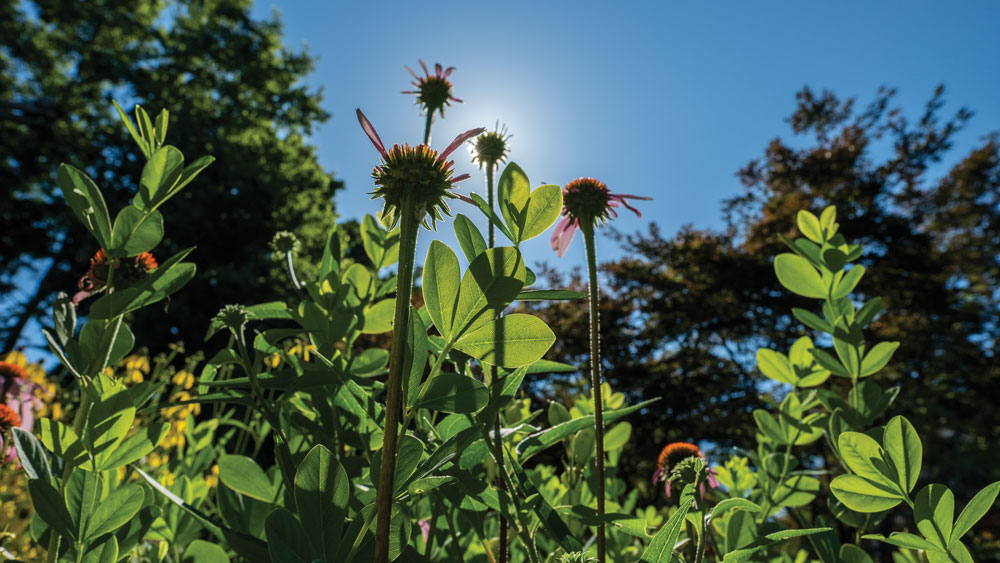The trees, shrubs and understory plants we’ve been cultivating in our yards do not support native biodiversity. The lawns we so prize are a food desert for nearly any species, save perhaps the Canada geese that now skip migrations to the tundra grasslands where they evolved and snowbird year-round in places like Kentucky. Indigenous insects cannot eat many of the imported, and sometimes invasive, ornamental shrubs and flowering plants we put in our gardens. With the corresponding reduction of insect numbers, birds and other animals that feed on them are in decline.
In his book Bringing Nature Home, Douglas W. Tallamy, a University of Delaware professor and leading exponent of the native-plant movement, warns about “the apparent disconnect between the typical goals of a gardener, to grow beautiful undamaged plants, and (using) gardens to produce lots of insects.” Margaret Carreiro is in the vanguard of local native-plant gardeners inviting monarch butterflies and other pollinators into their yards. Along with the local chapter of Wild Ones — a national organization that promotes, according to its website, “native plantings that create living landscapes” — Carreiro, a retired University of Louisville biology professor, advocates the spread of what are commonly referred to as “pollinator gardens” because they attract pollen carriers such as bees and butterflies.
For 15 years, Carreiro has been tending to her pollinator garden on her property near Lakeside Swim Club. One area in her “fully pollinated” backyard garden is filled with spring ephemerals. With names like Virginia bluebells, wild geraniums, mayapples and Dutchman’s breeches, they’re the first to bloom each year and, according to Carreiro, they’re essential for many native bees, including tireless mason bees and bumblebees. These native bees are, Carreiro says, better spring pollinators than honeybees. They move the fertilizing pollens of fruit trees such as apples, plums, pears and peaches from flower to flower and plant to plant. Both mason bees and bumblebees are solitary species that do not build hives like the congregating honeybees we know so well. These lesser-known bees emerge famished from their winter torpor and need a meal. “What we want to create here,” Carreiro says while describing her garden to me during my visit in May, “is not just a feast for the eyes but a feast for the insects.”
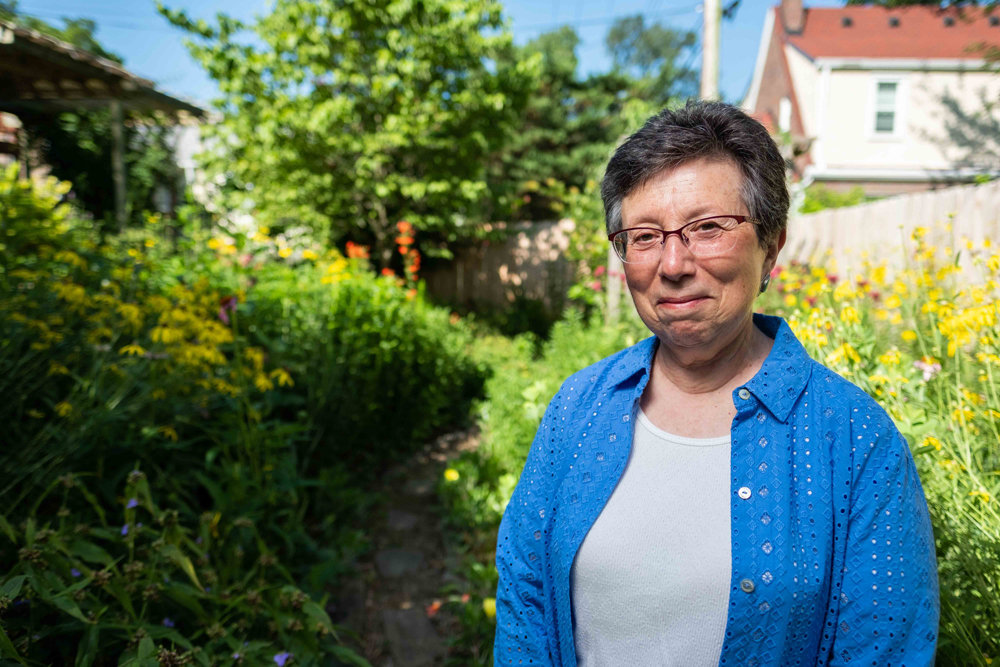
Margaret Carreiro at her home off Trevilian Way.
She points out that populations of insects in many places around the world have crashed an estimated 75 percent since 1970. In addition to recent concerns about declines of monarch butterflies, many people have been alarmed by the drop in honeybee numbers, another poster child in the awareness campaign about pollinators that help fertilize our crops and flowering plants. “Most people don’t realize that honeybees are from Europe,” Carreiro says. “They’re not our native honeybees, and we have a plethora of native bees that are crashing — including the bumblebee — especially in urban areas and on farms due to a host of factors. One is habitat loss; another is insecticide use.
“Our biodiversity is collapsing. This is what we’re trying to deal with,” Carreiro adds. “What I like about pollinator gardens is this: They’re not going to save all of the species, we know this, but we can choose what to do with our own property and it’s not dependent on the government. It’s dependent on what we would like done. I can’t save the Amazon, but I can do something in my own yard.”
No doubt, recent gloomy news about climate change, habitat destruction and other pressures put on the natural world by an ever-increasing human population can lead to paralysis. If so many species are already going extinct worldwide, what can an individual do in Louisville, Kentucky?
Preserving pollinators is now being seen as a first line of defense against the biodiversity crisis. In May, an international group of scientists released an assessment of the decline of plant, animal and insect species worldwide. This United Nations-backed group of experts reported that a million species now face extinction. The group’s former chairman told Science magazine, “What’s at stake here is a livable world.” As Elizabeth Kolbert wrote in the New Yorker in May: “The report points to pollinators as one group of organisms that humans can’t readily do without. Ninety percent of flowering plants and 75 percent of all types of food crops rely on pollination by animals — birds, bats, and (mostly) insects.”

Carreiro's garden filled with native plants.
Seen this way, converting lawn and garden space to the vegetation pollinators need to survive becomes more than a bug-watching, bird-attracting experience.
Blair Leano-Helvey, owner of Idlewild Butterfly Farm on Logan Street in Shelby Park, stresses that high-profile monarchs and honeybees represent only pieces of a larger pollinator-centric ecosystem, whose foundering could affect us all. Mason bees, she says, come out in early spring in 50-degree weather and are responsible for pollinating the area’s fruit trees. Once we get to 80-degree temperatures, those mason bees die out and native leaf-cutter bees do a lot of the pollinating with flowering plants. “If you had a total collapse (of biodiversity),” she says, “our grocery stores would look very different.”
In the Farmgate subdivision in Highview, where Anne Milligan and Steve Brown have gone native with their property, I watch along with them as a bulbous bumblebee crawls along a petal of a blue flag iris, then under an overleaf that protects the nectar and pollen near the flower’s center. The bee disappears for a moment for a drink, then re-emerges to flit to another petal and crawl out of view once again. “They travel in, like through a tunnel. Isn’t that cute?” says Milligan, a retired therapist. “As they go down this tunnel or passageway, all of the pollen is sticking to them.
“Yep, you can see it on his back legs,” she adds. “Just watching that gives me every bit of satisfaction for what we’re doing, right here. They’re naturally made to do that. I’ve watched other irises that are not native irises and the bees don’t (crawl) on them. Those irises are nice for humans; they’re not really nice for bumblebees.”
Milligan and Brown show me a garden bed in front of their home that borders a woodland area. It’s all green when I visit in early May, a month prior to an expected explosion of colorful blossoms. In early summer, the garden transforms into a multi-hued landscape painter’s dream, producing a palette of, among others, orange and purple coneflowers, yellow cut-leaf prairie dock, whitish Illinois bundleflowers and lavender-like blooms of the common milkweed.
Monarchs have evolved to lay eggs on the underside of milkweed leaves because their caterpillar larvae dine exclusively on the greenery of these plants. “Monarch butterflies and their caterpillars have devised antibodies that make them immune to the poisons in milkweed,” says Brown, a retired historian and educator with the National Park Service. “They have these vibrant colorings that would normally make them a target for predators. Instead, the colorings serve as a warning: Because milkweed is poisonous and monarchs are ingesting it, they become poisonous. So they don’t have a lot of natural predators, which is pretty darn clever.” Native vegetation experts also recommend late-season blooming plants like aromatic asters for gardeners hoping to give monarchs a boost during migration. “They have to have someplace to refuel while they make their trek to Mexico,” Idlewild’s Leano-Helvey says. “They’re going 2,000 miles and need pit stops.”
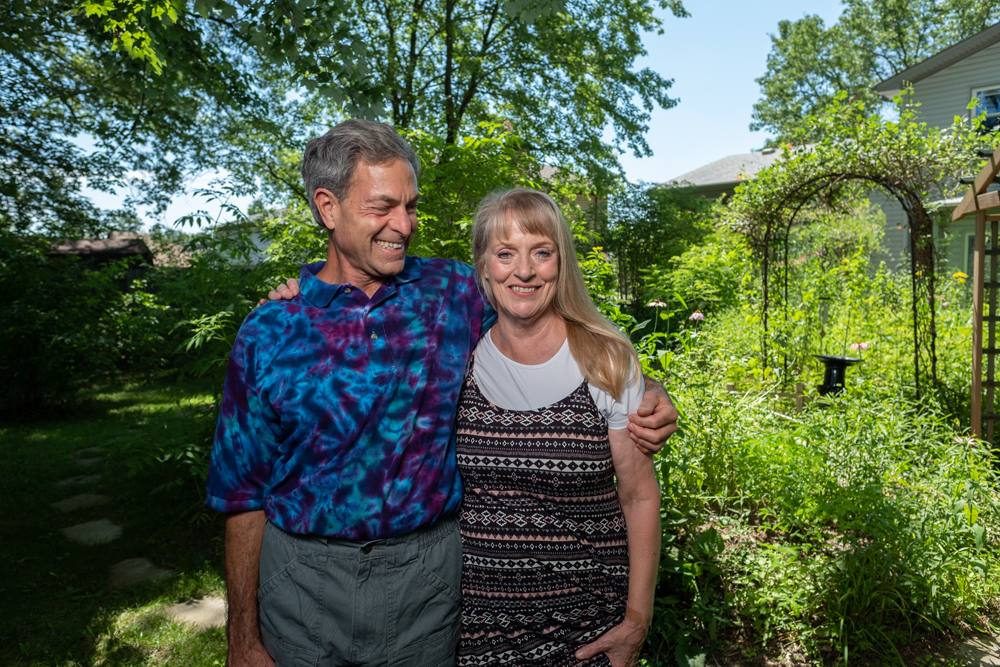
Anne Milligan and Steve Brown in Highview.
When Brown was with the Park Service, as historian at Abraham Lincoln’s birthplace in Hodgenville, Kentucky, he and Mulligan lived in a home surrounded by woodlands. They wanted to re-create that environment when they moved to Louisville in 2010, where Milligan was seeing clients as a mental-health therapist. They found their home using Google Earth, searching for available properties at the edge of woods. “We then set about creating as natural a setting as we could,” Milligan says.
In addition to milkweed for the monarchs, they’ve planted other butterfly magnets. Certain caterpillar species have evolved to ingest the foliage of just one plant. The larval stage of the spicebush swallowtail butterfly — a beautiful dotted, kite-like creature — can eat only leaves of the spicebush plant. The zebra swallowtail (which has, you guessed it, white stripes) dines only on the leaves of pawpaw trees during its larval stage. Brown and Milligan put in pawpaw trees and spice bushes to accommodate them.
The couple turned their side yard into an extension of the adjacent woods and dug up non-native plants in front, replacing them with a wide variety of species local pollinators crave. They left some turf grass in front to comply with the look of the rest of the subdivision, but exchanged pollinator-friendly native bushes for the existing hedgerow. Then they completely “de-lawned” the back, crafting rain gardens and adding bushes and a few small trees to turn it into a concentrated botanical wonder. Some unexpected plants sprouted up to join the party. “When you start getting rid of these non-native plants, all of these seeds that have been biding their time start to appear, like jewelweed,” Brown says, mentioning the homeopathic cure for poison ivy. “And it has these beautiful tubular blossoms. It’s orange, and it just grows everywhere.”
The couple is constantly on surveillance for Japanese (white) honeysuckle, one of the worst and most pervasive invasive species, as it tries to colonize their property from the adjacent woods. On the other hand, the native coral honeysuckle that has grown to regularly present a sizable wall of light-red flowers has become a favorite. “It blooms three times (a year) and the hummingbirds love them,” Milligan says. “They hover over several small flowers. Not only do we get the scouts in the spring, but we get nesting pairs in the summer and the migratory ones in the fall.”

Phyllis Croce and John Frey's “pollinator oasis” property in Jeffersonville.
Phyllis Croce and John Frey’s home on Riverside Drive in Jeffersonville has become a pollinator oasis among the lawns and walkways near the Big Four pedestrian bridge. Frey, a retired restaurateur, purchased the home in 1976, and, for his first landscaping project, tore out the invasive English ivy that had claimed much of his land. Croce, a retired landscape-restoration specialist at the Metropolitan Sewer District, brought in river oats, a shade grass that produces seeds eaten by both caterpillars and birds. That was 25 years ago. Now, Croce and Frey have gone 100-percent pollinator, with both the front and back of the property turned over to a dense covering of almost exclusively native plants. Walk down the sidewalk between the Big Four and restaurants such as KingFish and Buckhead Mountain Grill and you see one home standing out amid those with small front lawns and tightly circumscribed gardens. A sea of tall flowering plants swaying in the wind surrounds the Croce and Frey house.
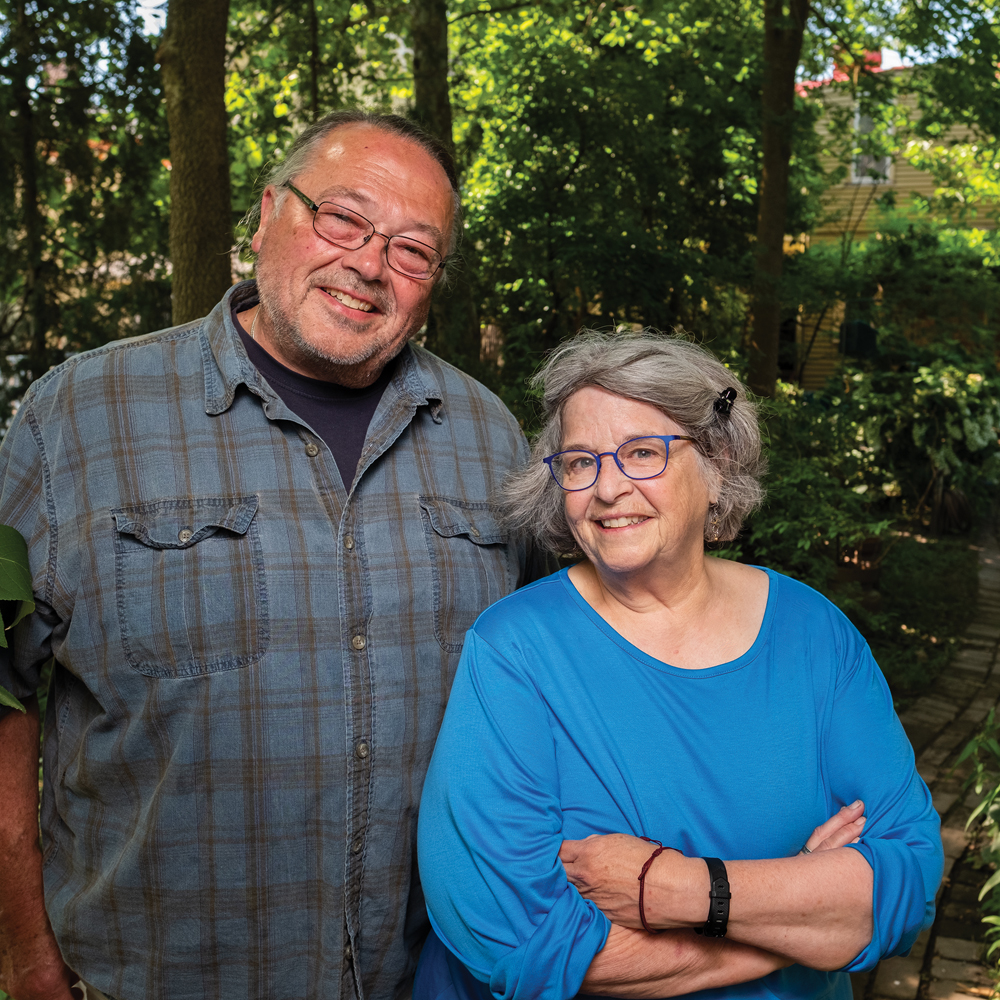 John Frey and Phyllis Croce. John Frey and Phyllis Croce. |
One exception in this native-species oasis is the oakleaf hydrangea in a front corner of the property. Its range in the woods and near stream banks isn’t typically described north of Tennessee, but it blossoms into a show-stopping white that convinced the couple to leave it in place. “When the oakleaf hydrangea blooms out it’s like a beacon,” Croce says. Everyone stops and says, ‘What plant is that?’ That’s when I started labeling things.” We do a quick inventory of the front garden, serenaded by the “cheer-cheer-cheer-up” of a robin. Croce has posted handwritten names of the plants densely packed into what was once a front yard, so passersby can know what they’re seeing as they stroll by. Prairie and woodland species including Joe Pye weed, spiderwort, columbine and milkweed are among them. Many of these plants are food sources for caterpillars. And speaking of caterpillars: In addition to growing up to become pretty pollinators, they provide a major link in the food web. Caterpillars are for birds what cheesy omelets once represented for my wife and myself: a go-to food source for offspring. “Caterpillars are about 80 to 90 percent of the food for birds to feed their offspring,” Carreiro says. “So without caterpillars, you’re not going to have as many birds.”
Along the side of the house near a hazelnut tree, Croce has planted bloodroot, mayapple, wild ginger and other natives. A few trees have been added in back, including hackberry, which is wildly popular with caterpillars of several butterfly species (including the hackberry emperor, which deposits its eggs on the tree’s leaves). Blueberry, bottlebrush buckeye, spicebush and other shrubbery grow behind the house as well.
In this welcoming environment, Croce and Frey have spotted spicebush swallowtails, both yellow and blue swallowtails and the beloved monarchs. A big bonus is the birds that find their way to this insect-friendly slice of Jeffersonville. The couple has identified an eastern towhee, black-and-white warblers and various sparrows among their native gardens, along with the standard cardinals, robins and blue jays. Frey’s favorite is the wood thrush, with its sonorous trilling call. This bird winters in Central America, flying across the Gulf of Mexico in a single night. Likely on its way to breeding grounds to our north, it stops in spring to entertain Frey and Croce for a few weeks.
“We’ve been taught to kill insects, to be afraid of things that crawl,” Croce says. “But we’re part of this ecosystem, even the smallest parts of it.” He mentions wild ginger and its small red flower that lies on the ground and is propagated by crawling insects. The seeds that later develop are carried underground by ants, who eat an oily appendage to the seed and then leave the rest to sprout undisturbed by other hungry creatures.
The couple once was cited by the city of Jeffersonville for having vegetation hanging out over the sidewalk, but has never been told to remove any of the native plants. Croce says they attempt, with neighbors in mind, to keep the property from looking too “weedy” during non-flowering seasons. She admits that they’ve run out of room to add to their gardens. “We’ve reached peak,” she says.
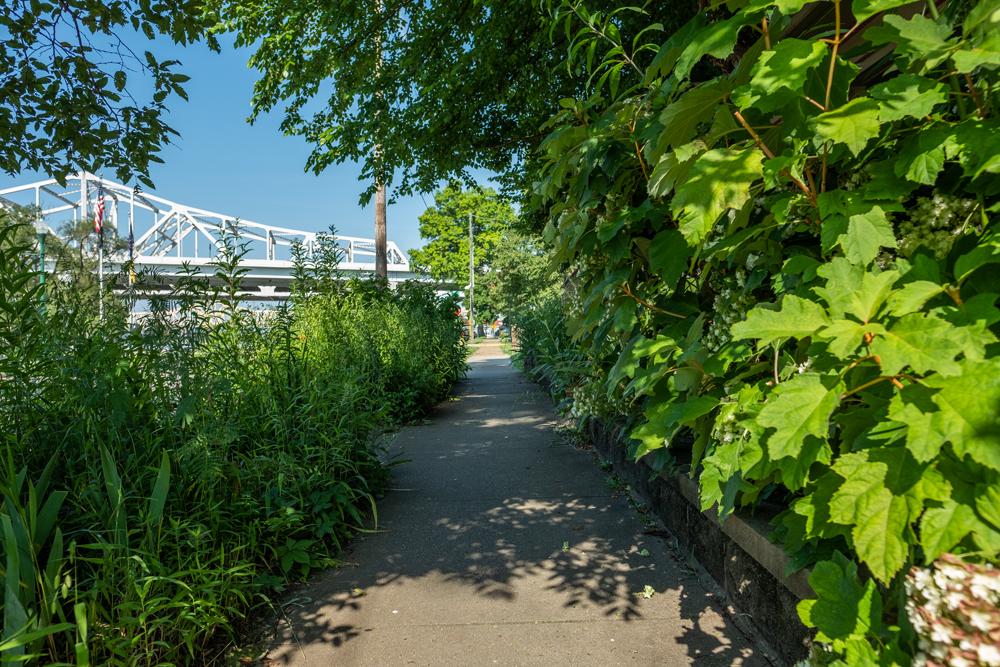
Croce and Frey's property.
Margaret Shea, the owner of Dropseed Native Plant Nursery in Goshen, specializes in the native plants that our fauna evolved to coexist with. She has a master’s degree in ecology, and, prior to opening the nursery, worked at Bernheim Forest, focusing on the restoration of damaged areas within the preserve. She rooted out invasive species, reintroduced controlled burns and conducted stream rehabilitations. Before she began, invasives dominated some areas that had been farmed and logged, particularly fescue grasses that had been planted for raising cattle. While rebuilding Bernheim, she says, “I couldn’t find any local sources for native plants. I had to go to Chicago or Missouri to find seeds or plant materials.”
 |
Fifteen years ago, she opened Dropseed, thinking she’d do the installation and maintenance of pollinator gardens for local residents and businesses. (Carreiro was one of her first customers.) However, sales to home gardeners purchasing native plants have grown so much in recent seasons that she no longer performs installations. There are approximately 200 species potted and for sale in her greenhouse and in surrounding outside areas. Many Dropseed plants are grown from seed by Shea or divided from the previous year’s crop. “I collect them and then typically I’ll start a bed here or other places where I have seed-production plots,” she says. “I never dig in the wild, which disturbs the site and makes it possible for invasives to move in.” Her knowledge of the state’s unique natural areas and network of acquaintances that call her when they locate something new keep her inventory expanding. “I love, love, love going out and finding new species and collecting the seeds from them,” she says.
Shea recommends first removing invasive plants, pointing to bush honeysuckle, burning bush and English ivy as main offenders that spread and take over surrounding environs. “These ornamental plants are really harmful to our environment on a big scale,” she says.
The plants she most often recommends for homeowners starting a pollinator garden are those that serve as nectar sources. They include mountain mints (parasitoid wasps are drawn to them), coneflowers (they bloom in summer for up to a month and later provide a good seed source for birds) and asters and goldenrods (as fall bloomers, they supply needed nectar for monarchs preparing for that long migration to Mexico or other species storing energy for winter). Grasses that supply hollowed stocks for native bee hibernation are a good choice, and hummingbirds and butterflies are drawn in spring to the colorfully named hairy beardtongue.
“Think about the full growing season,” Shea says. “Sometimes people forget about having a nectar source available throughout the growing season. You need a mixture of species that flower at different times.”
Idlewild Butterfly Farm, which opened in 2015, is another resource for insect-friendly native plants. “You don’t have to build your pollinator-monarch garden all in one season,” Blair Leano-Helvey says. “You can just add to it each season. Even when we deal with folks who have lawn care, we can dedicate just one corner, and if they’re not going to spray (pesticides) it can be impactful. We also have some pollinator plants that do well in pots on balconies or decks.”
Leano-Helvey and her staff protect butterflies in an outdoor “flight house,” a wire-enclosed aviary that features a variety of mostly annual plants the insects favor. An incubation area inside with aquarium-like tanks is used to hatch out some of the monarch and swallowtail chrysalises. The caterpillars and their chrysalises stay out in natural temperatures through early spring before some are brought in for the hatching and later released in the flight house. Last year, Idlewild partnered with the Louisville Zoo to create a Kentucky butterfly exhibit.
Leano-Helvey points to a patch of milkweed in the area behind the building where the aviary and for-sale native plants predominate. What started as one plant has spread vigorously in this urban garden. “It’s because of this species right here: common milkweed,” Leano-Helvey says. “It has a pretty intense taproot that can run 15 to 20 feet underground. But we get a lot of wild butterflies here, so we like to have a lot of nectar for them.”
Three years ago, the monarch’s allure inspired Sean and Donna Delahanty to plant milkweed at their Highlands home near Tyler Park. They’ve turned their terraced front yard into a garden that now contains a mixture of native and non-native species. It’s something of a trial-and-error nursery.

Butterfly-attracting milkweed.
Among the coneflowers, Jethro Tull, hydrangeas and butterfly bushes are a few mysteries. Sean points to one not-yet-flowering piece of vegetation in the midst of purposefully planted specimens. “This thing right here, it just showed up. I don’t know what it is, but I really like it,” says the former Jefferson County District Court judge. There are thistles, ornamental grasses, butterfly weed and a small pin oak and dogwood tree mixed in on the three levels in front. They’ve installed a shade garden and other colorful flowers and shrubs in back. It could well be the thistles that have rewarded the Delahantys with a striking pair of goldfinches; the yellow male and its mate use down from these thistles to line their nests and, of course, dine on the seeds.
The first September after putting a half-dozen common milkweed plants in front and another six in back of the house, the Delahantys counted 50 green monarch chrysalises on these plants. When some disappeared overnight they pulled 10 or so into the house to incubate and let the adult monarchs go when they arrived. “I like the monarchs, but I’m a little disappointed we’ve only had them one out of three years,” he says. “If we get monarchs it’s fabulous. If we don’t I spend too much of my summer digging this milkweed up.” Its runner-type roots allow this species to show up uninvited elsewhere in the garden.
No doubt, monarchs would more consistently move in with the Delahantys if more gardens with the requisite milkweed species existed in their neighborhood. That’s why proponents of the native-plants movement are trying to spread the seed more widely. Carreiro makes public appearances on the topic and proselytizes to anyone who will listen. She wants to include even the suburban subdivisions notorious for regulations that require lawns and restrict gardens. The argument is this: Even if most residents in a neighborhood assign just a small portion of their property to native plants, it can provide food and pollinator habitat for populations able to connect from yard to yard. “Cities and suburbs can play a role,” she says, “but we’ve been growing turf grass and annuals and some perennials that are mostly of European or Asian origin. They’re not well matched to our pollinators.”

Before she retired from U of L in 2018, Carreiro assigned a student the task of analyzing maps of Jefferson County’s 330-plus square miles. The student found that approximately 35 percent of the land is zoned residential. Further analysis revealed that the footprints of all houses, roads and other hard-paved surfaces on that residential land take up about 4 percent of that residential property. The bottom line: Approximately 31 percent of the county, nearly one-third, is what Carreiro describes as “plantable space in residentially zoned land. If even 10 percent (of that 31 percent) became native plant pollinator space, it would really contribute,” she says. “It would create stepping stones, corridors for movement to allow species to live in the area and also move through it.
“One hundred or so years ago people knew all the names of the birds and the fish and the insects because there was more nature around us. People were surrounded by nature a hundred years ago, and now nature is surrounded by people.”
This originally appeared in the August 2019 issue of Louisville Magazine under the headline "Where the Wild Things Are." To subscribe to Louisville Magazine, click here. To find us on newsstands, click here.
Photos by Joon Kim, studiojoon.com

